1997 CADILLAC SEVILLE seat memory
[x] Cancel search: seat memoryPage 10 of 370

Downloaded from www.Manualslib.com manuals search engine c
c
c
advances such as air suspension, memory seat,
automatic electric door locks. transistor radio,
a brushecl
stainless
steel roof and low profile tires.
For the 1948 model, Cadillac introduced the legendary
tail fin which once more set the trend in automotive
styling for nearly two decades. This
was closely
followed with the two door hardtop Coupe DeVille and
the industry's first modern overhead valve, high
compression
V8 engine on the 1949 model.
Engineering innovations, conveniences
and styling
dominated the
'50s and '60s. Cruise control, automatic
climate control, tilt
and telescoping steering wheels,
twilight sentinel and
four door hard tops all debuted in
these years.
Ir, 1557 the Eldorado Brougham featured
1957 Eldorado Brougham
:.x
The Eldorado, introduced in 1953, was redesigned for
1967
as the first front wheel drive personal luxury car.
The
472 cu. in. V8 engine used in all Cadillacs in I568
and 1965 was enlarged to SO0 cu. in. for all 1970
through 1976 Eldorados. The Track Master
conlputerized skid control braking system option
debuted
on 1970 Eldorados.
A driver and passenger Air Cushion Restraint
system (air bag) was available on
all 1974. I975 and
1976 Cadillacs.
Analog Electronic
Fuel Injection was available, on
1975 Cadillacs and standard 011 the new international
size
1976 Seville. In 1978, the Trip Computer option
incorporated the first on-board microprocessor.
ix
Page 18 of 370

Downloaded from www.Manualslib.com manuals search engine c
.-
c
If you have the optional personalization package, the
power lumbar control can be programmed for memory
recall. For more information, see "Memory Seat and
Mirrors'' later in this section.
Adjust the driver's seat
(including lumbar
adjustments) and both
outside mirrors
to a
comfortable position and
then press the
SET button.
Within
five seconds, press
button
"1 ."
A second mi~ror and seating position may be programmed
by repeating the above steps and pressing button
"3''
instead of button 1. Note that each time a memory button
is pressed.
a single becp will sound through the radio.
If your vehicle is in PARK (P), you can recall mirror and
seating positions by briefly pressing button
1 or 2. This
will adjust the seat and nlirrors
to where you have
previously programmed them.
If you have accidentally
pressed one
of the memoly recall buttons and want to stop
seat or mirror movement, press one
of the manual seat or
mirror control buttons. This cancels a memory recall.
You can also recall a seat and mirror position if your
vehicle is
not in PARK (P). Press and hold either the
1 or 2 button until seat and mirror movement is
complete. Releasing the buttons will stop adjustment.
The
EXIT button can be programmed to allow easy exit
for up to
two drivers. Adjust the seat to a comfortable
"exit" position and then press the
SET button followed
by the
EXIT button. While your vehicle is in PARK (P).
briefly press the
EXIT button to recall your programmed
exit position.
Automatic seat and mirror movement will occur if the
Remote Keyless Entry (RKE) transmitter is used to
enter the vehicle. The number
on the back of the
transmitter corresponds to the
1 or 2 seat and mixl-or
position. After the unlock button is pressed on the
RKE
transmitter or when the key is placed in the ignition, the
seat and mirrors will automatically adjust to the
appropriate position.
Page 19 of 370
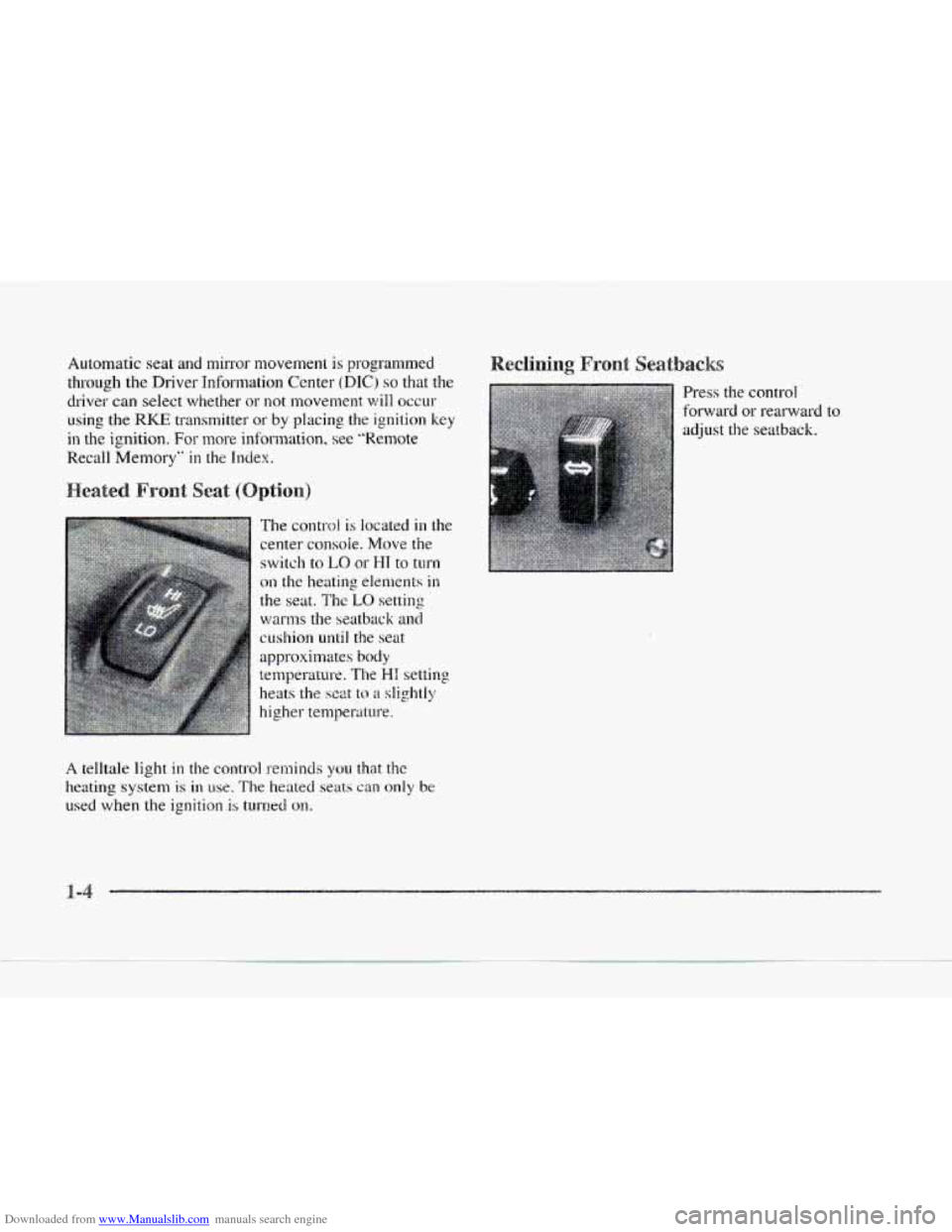
Downloaded from www.Manualslib.com manuals search engine Automatic seat and mirror movement is programmed
through the Driver Information Center
(DIC j so that the
driver can select whether or
not n~ove~nent will occur
using the RKE transmitter or by placing the ignition key
in the ignition. For more information, see "Remote
Recall Memory"
in the Index.
The control is located in the
center
console. Move the
switch
to LO or HI to turn
on the heating elements
in
the seat. The LO setting
warms the seatback and
cushion until the seat
A telltale light in the control reminds you that the
heating system
is in use. The heated seats can only be
used when the ignition is turned on.
Press the control
forward
or reatward
adjust the
seatback.
to
Page 70 of 370
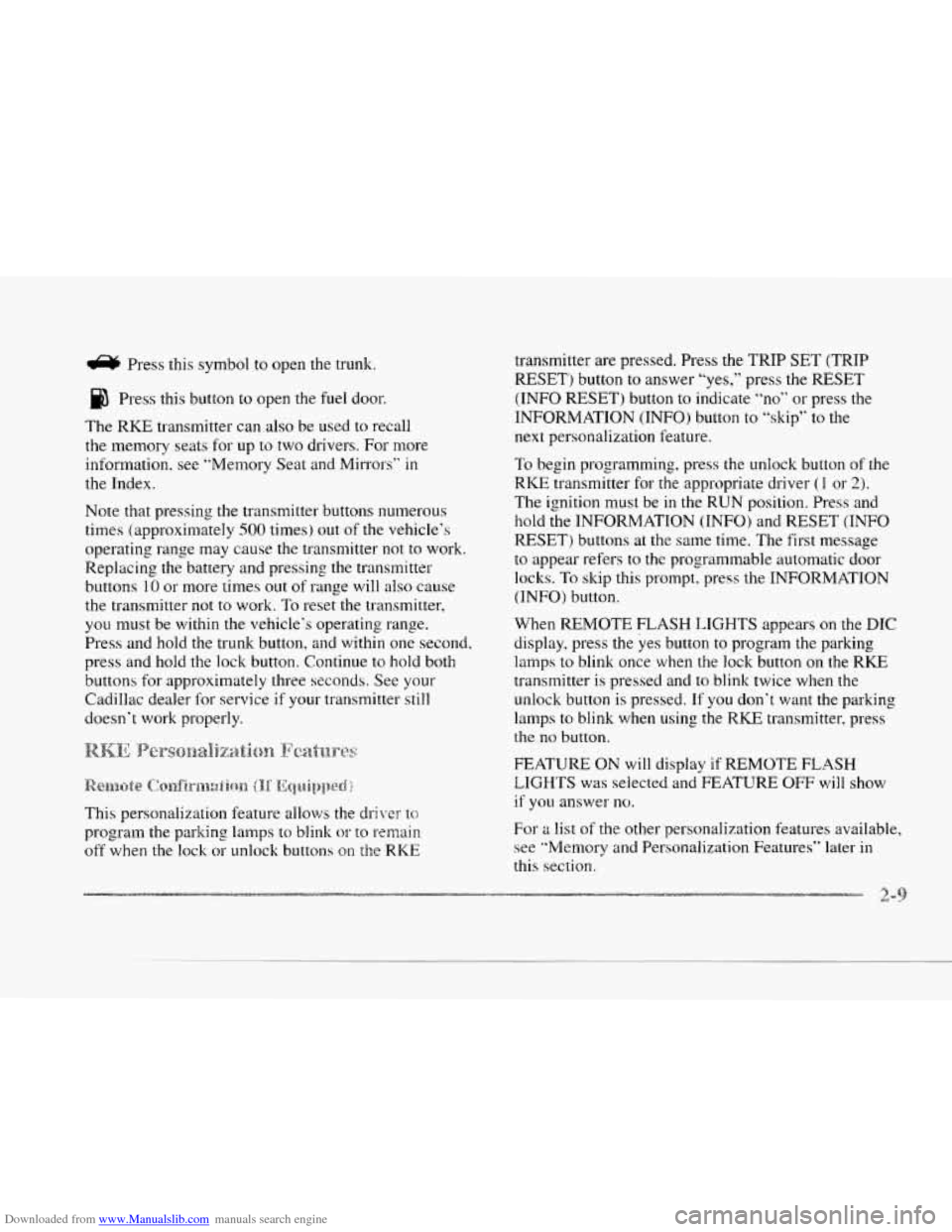
Downloaded from www.Manualslib.com manuals search engine c
L
c
e Pras this symbol to open the trunk.
Press this button
to open the fuel door.
The RKE transmitter can also be used to recall
the memory seats for up to two drivers.
For rnore
information, see “Memory Seat and Mirrors”
in
the Index.
Note that pressing the transmitter buttons numerous
times (approximately
500 times) out of the vehicle’s
operating range may cause the transmitter not to work.
Replacing the battery and pressing the transmitter
buttons
10 or more times out of range will also cause
the transmitter not to work. To reset the transmitter,
you must be within the vehicle’s operating range.
Press and hold the trunk button,
and within one second,
press and hold the lock button. Continue to hold both
buttons
for approximately three seconds. See your
Cadillac dealer for service
if your transmitter still
doesn’t work properly.
This personalization feature
allo\vs the drikw tc;
program the parking lamps to blink or to remain
off when the lock or unlock buttons on the RICE
transmitter are pressed. Press the TRIP SET (TRIP
RESET) button
to answer “yes,” press the RESET
(INFO RESET) button to indicate
“no” or press the
INFORMATION (INFO) button
to ”skip” to the
next personalization feature.
To begin programming, press the unlock button of the
RICE transmitter for the appropriate driver (1 or 2).
The ignition must be in the RUN position. Press and
hold the INFORMATION (INFO) and RESET (INFO
RESET) buttons at the same time. The first message
to appear refers to the programmable automatic door
loclts.
To skip this prompt. press the INFORMATION
(INFO) button.
When REMOTE FLASH
LIGHTS appears on the DIC
display, press the yes button to program the parking
lamps
to blink once when the lock button on the RKE
transmitter is pressed and
to blink twice when the
unlock button
is pressed. If you don‘t want the parking
lamps
to blink when using the RKE transmitter, press
the
no button.
FEATURE
ON will display if REMOTE FLASH
LIGH’TS
was selected and FEATURE OFF will show
it you answer no.
For a list of the other pe.rsonalization features available,
see “Memory
and Personalization Features” later in
this section.
Page 117 of 370

Downloaded from www.Manualslib.com manuals search engine 2. Hold in the CAL switch (on the bottom of the mirror
housing) for five seconds until the cunent zone entry
number appears in the display.
To hold in the CAL Your Cadillac has an
switch, insert
a paper clip into the small hole on the electric mirror control
bottom of the mirror housing. located on the driver’s
3. Press the CAL switch until the number for the new door armrest.
zone entry is displayed.
Once the desired zone number is displayed, stop
pressing the CAL switch and the display will
show
compass direction within a few seconds.
Move the switch
in the middle of the control to choose
the right
or left mirror. To adjust the mirror, push the
arrow control in the direction
you want the mirror to go.
Adjust each mirror so you can see the side of your
vehicle and the area behind your vehicle.
The mirrors can also be programmed for personalization if
you have the optional memory package. For more
information, see “Memory Seat and
Min-ors“ in the Index.
Page 146 of 370
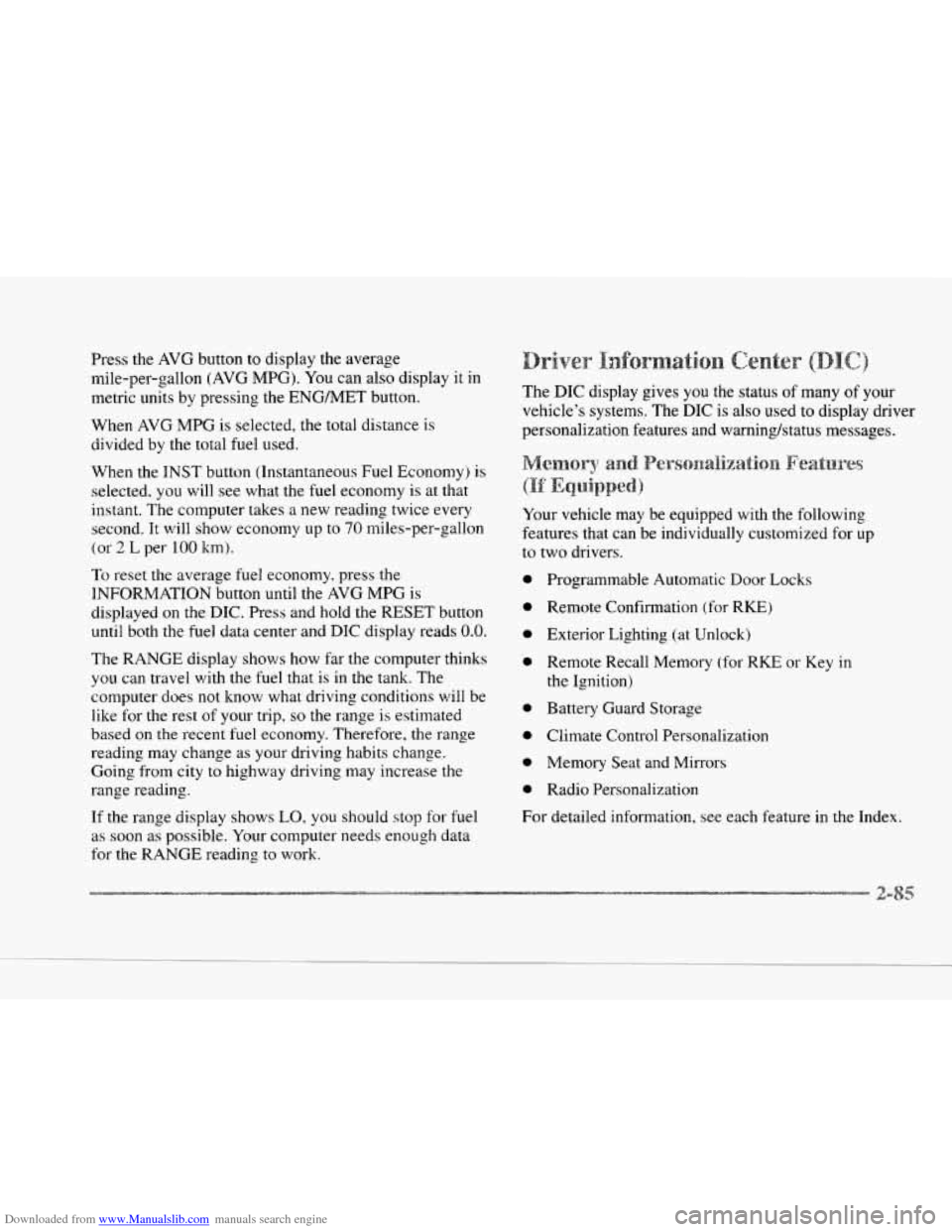
Downloaded from www.Manualslib.com manuals search engine IC-
Press the AVG button to display the average
mile-per-gallon (AVG MPG). You can also display it in
metric units by pressing the
ENGMET button.
When AVG MPG
is selected, the total distance is
divided by the total fuel used.
When the INST button (Instantaneous Fuel Economy) is
selected. you will see what the fuel economy is at that
instant. The computer takes
a new reading twice every
second.
It will show economy up to 70 miles-per-gallon
(or 2 L per- 100 ltm).
To reset the average fuel economy, press the
INFORMATION button until the AVG MPG is
displayed on the DIC. Press and hold the
RESET button
until both the fuel data center and DIC display reads
0.0.
The RANGE display shows how far the computer thinks
you can travel with the fuel that is in the tank. The
computer does
not know what driving conditions will be
like for the rest of your trip,
so the range is estimated
based on
the recent fuel economy. Therefore, the range
reading may change
as your driving habits change.
Going from city
to highway driving may increase the
range reading.
If the range display shows
LO, you should stop for fuel
as soon
as possible. Your computer needs enough data
for the RANGE reading to work. The
DIC display gives you the
status of many of your
vehicle’s systems. The DIC is also used to display driver
personalization features and warninghtatus messages.
Your vehicle may be equipped with the following
features that can be individually customized for up
to two drivers.
0
0
0
0
0
0
0
0
Programmable Automatic Door Locks
Remote Confirmation (for
RKE)
Exterior Lighting (at Unlock)
Remote Recall Memory (for RKE or Key
in
the Ignition)
Battery Guard Storage
Climate Control Personalization
Memory Seat and Mirrors
Radio Personalization
For detailed information, see each feature in the Index.
Page 169 of 370
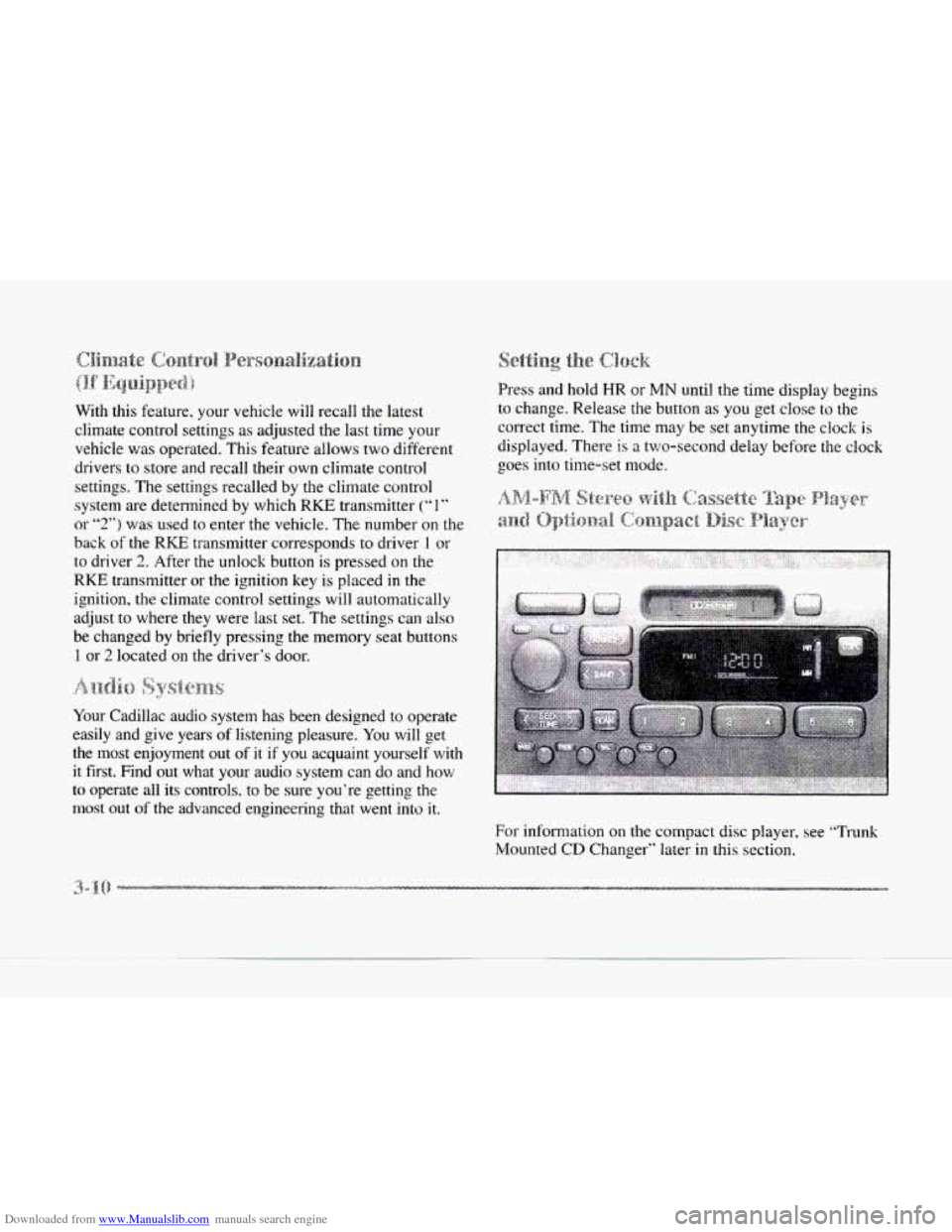
Downloaded from www.Manualslib.com manuals search engine With this feature, your vehicle will recall the latest
climate control settings
as adjusted the last time your
vehicle was operated. Thjs feature. allows two different
drivers to store and recall their own climate control
settings. The settings recalled by the climate control
system are determined
by which RKE transmitter (“1”
or “2“) was used to enter the vehicle. The number on the
back of the
RKE transmitter corresponds to driver 1 or
to driver
2. After the unlock button is pressed on the
RKE transmitter or the ignition key is placed in the
ignition, the climate control settings will automatically
adjust
to where they were last set. The settings can also
be changed by briefly pressing the memory seat buttons
1 or 2 located on the driver’s door.
i,C) ~~~~~~~~~.~ 5’
Your Cadillac audio system has been designed to operate
easily and give years of listening pleasure.
You will get
the most enjoyment
out of it if you acquaint yourself with
it first. Find out what
your audio system can do and how
to operate all its controls, to be sure you’re getting the
most out of the advanced engineering that went into
it.
Press and hold HR or MN until the time display begins
to change. Release
the button as you get close to the
correct time. The time may be
set anytime the clock is
displayed. There is a two-second delay before the clock
goes into time-set mode.
For information on the compact disc player, see “Trunk
Mounted
GD Changer” later in this section.
-.
.d
Page 184 of 370
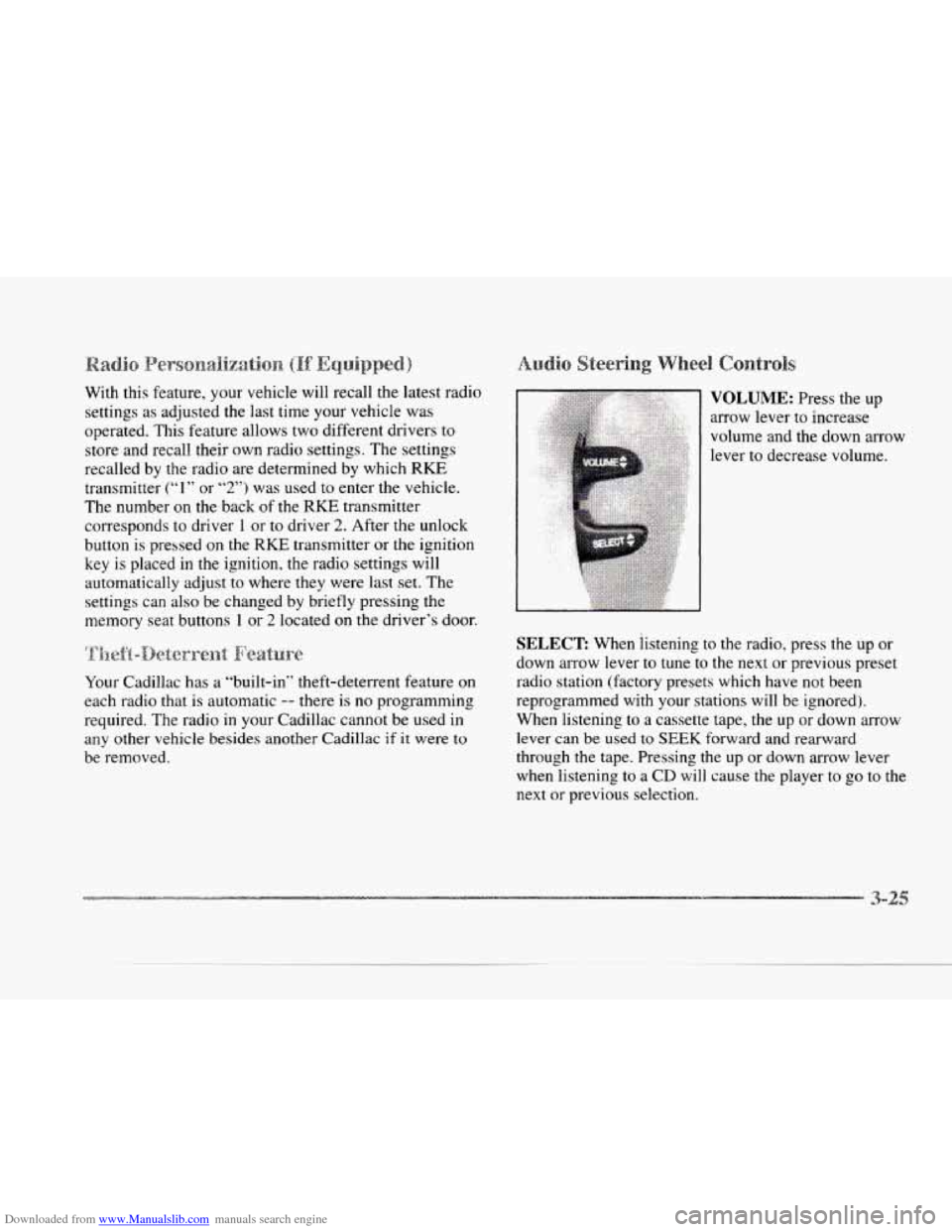
Downloaded from www.Manualslib.com manuals search engine c
c1
c
P
With this feature, your vehicle will recall the latest radio
settings as adjusted the last time your vehicle was
operated. This feature allows two different drivers
to
store and recall their own radio settings. The settings
recalled by the radio are determined by which
RKE
transmitter (“1” or “2’’) was used to enter the vehicle.
The number on the back
of the RKE transmitter
corresponds
to driver 1 or to driver 2. After the unlock
button is pressed
on the RKE transmitter or the ignition
key
is placed in the ignition, the radio settings will
automatically adjust to where they were last
set. The
settings can also be changed
by briefly pressing the
memory seat buttons 1 or
2 located on the driver’s door.
Your Cadillac has
a “built-in“ theft-deterrent feature on
each radio that is automatic -- there is no programming
required. The radio in your Cadillac cannot be used in
any other vehicle besides another Cadillac if it were to
be removed.
VOLUME: Press the up
arrow lever to increase
volume and the down arrow
lever to decrease volume.
SELECT: When listening to the radio, press the up or
down arrow lever
to tune to the next or previous preset
radio station (factory presets which have not been
reprogrammed with your stations will be ignored).
When listening to a cassette tape, the up
or clown arrow
lever
can be used to SEEK forward and rearward
through the tape. Pressing the up or down arrow lever
when listening to a
CD will cause the player to go to the
next or previous selection.
3-2